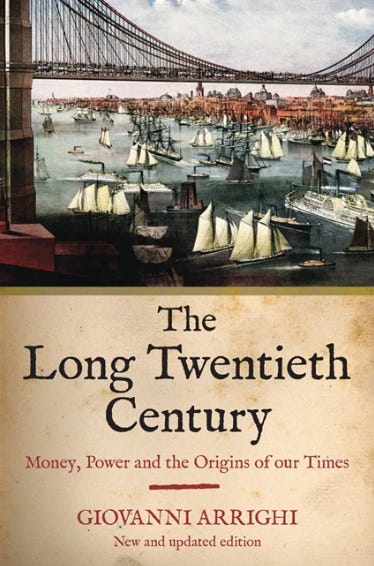Review: The Long Twentieth Century, by Giovanni Arrighi
When Giovanni Arrighi wrote The Long 20th Century, he set out with the ambitious goal of telling the story of capitalism as a world system from its embryonic stages in the Italian Renaissance to the post-Cold War moment of American hegemony. To build his magnum opus, Arrighi draws upon a diverse array of thinkers from Karl Marx to Fernand Braudel. Arrighi’s thesis is that while finance is an inherent part of capitalism, over financialization leads to systemic crises and financialization is the ‘autumn’ of a capitalist regime.
In Marx’s classical formulation: MCM’, the money form (M) represents liquidity while commodities (C) are rigid. Finance represents liquidity, which is essential to capitalism and increasing financialization is seen as a maturation of capital.
While explaining the historical context behind capitalism as a world system, Arrighi presents an alternate formulation of MCM’ to describe empire. Arrighi proposes MTM’ and TMT’, where territory is (T) and money is (M). The MTM’ formulation is the capitalist formulation, where the state acquires additional territory in order advance more capital. The diametric of the capitalist formulation is the territorialist formulation where capital is expended to expand the size of the state. Each of the states studied by Arrighi represents a combination of both MTM’ and TMT’ logic.
In The Long 20th Century, Arrighi examines four distinct historical phases in the development of capitalism as a world system. He examines the Italian city-states of the Renaissance (Genoa in particular), the Dutch United Provinces, the British Empire, and the modern United States. Arrighi defines these states as the hegemonic empires of their day, where hegemony not only represents the individual state’s might but also their leadership over other states. For each of these states there was an initial phase of expansion defined by MC, followed by a phase of consolidation and financial expansion CM’. During their MC phase, each of these regimes expanded through a combination of commerce, industrialization, and settler-colonialism. Arrighi proposes that after a period of expansion and capital accumulation, these states eventually face crises and enter an ‘autumn’ period of financialization.
Why then did these states switch to finance capital over commercial and industrial capital? Arrighi provides some reasons during his study of history that makes up the bulk of the book. As the capitalist regime develops, crises such as decreases in profits, decreases in productivity, and increased competition from other states start to overwhelm the hegemon. Instead of destroying the current regime, Arrighi postulates that financialization provides liquidity and delays the unravelling of the current regime. Thus, financialization is a lifeline that a capitalist regime in decline can use to buy more time.
What are my thoughts on the book then? As a grand history account, I quite enjoyed The Long 20th Century, I was able to read majority of the book and picked up on the historical knowledge without much difficulty. Compared to other more well-known history books of the type, I would say The Long 20th Century compares favorably. This book presents an account of the development of capitalism and the European states that is grounded in materialism rather than determinism and in my mind, provides a superior account of history compared to say Guns, Germs, and Steel (GGS). In Arrighi’s book his explanation for the development of capitalism and imperialism in Europe rather than China comes down to economics. For centuries, the balance of payments was in China’s favor, silver and gold coinage from Europe was exchanged for finished Chinese goods. As the balance of payments was in Imperial China’s favor, the Chinese had no reason to develop a naval force and seek capital from abroad, unlike the Europeans. Whereas in GGS, Diamond attributes the development of China largely to deterministic factors such as geography.
While The Long 20th Century is a decent history book, I feel it falls flat on its study of economics and capitalism. In the introduction, Arrighi stated that his book would only examine the finance side of capitalism and he excluded a study of class struggle and the working class as this was already examined in-depth by Marx. I do believe that omitting the class struggle weakens Arrighi’s thesis and his study of the history of capitalism and the world system it created.
I personally found the postscript added to the second edition of the book to be one of the more interesting parts, where he examines the rise of China within the current Western-led order. Arrighi wrote the postscript shortly before he passed away in 2009. In the postscript, Arrighi sees China’s rise as a possibility for a break from the previous 500 year Western-led capitalist world system. Arrighi added this postscript while he was witnessing the unprecedented growth of China’s economy and the decline of American power.
Rating: 3/5




